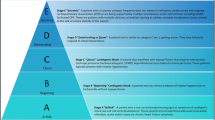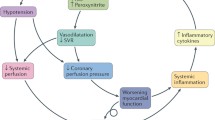Abstract
Cardiogenic shock (CS) remains the most common cause of in-hospital mortality in the setting of acute myocardial infarction (AMI). Recent data have identified several concerning trends in the field of AMI-CS that include an overall increase in mortality, an increase in patient complexity, minimal use of acute mechanical circulatory support (AMCS) devices with the majority being implanted as a bailout option. In this review, we will discuss recent trends in CS and the rationale for the use of acute mechanical circulatory support pumps early in the clinical treatment of CS.





Similar content being viewed by others
References
Papers of particular interest, published recently, have been highlighted as: • Of importance •• Of major importance
Menees DS, Peterson ED, Wang Y, Curtis JP, Messenger JC, Rumsfeld JS, et al. Door-to-balloon time and mortality among patients undergoing primary PCI. N Engl J Med. 2013;369:901–9.
McNamara RL, Kennedy KF, Cohen DJ, Diercks DB, Moscucci M, Ramee S, et al. Predicting in-hospital mortality in patients with acute myocardial infarction. J Am Coll Cardiol. 2016;68:626–35.
Wayangankar SA, Bangalore S, McCoy LA, Jneid H, Latif F, Karrowni W, et al. Temporal trends and outcomes of patients undergoing percutaneous coronary interventions for cardiogenic shock in the setting of acute myocardial infarction: a report from the CathPCI Registry. J Am Coll Cardiol Intv. 2016;9:341–51.
Ezekowitz JA, Kaul P, Bakal JA, Armstrong PW, Welsh RC, McAlister FA. Declining in-hospital mortality and increasing heart failure incidence in elderly patients with first myocardial infarction. J Am Coll Cardiol. 2009;53:13–20.
• Shah RU, de Lemos JA, Wang TY, Chen AY, Thomas L, Sutton NR, et al. Post-hospital outcomes of patients with acute myocardial infarction with cardiogenic shock: findings from the NCDR. J Am Coll Cardiol. 2016;67:739–47. Cardiogenic shock complicating AMI is an ongoing problem that causes significant mortality in this population, necessitating improved management strategies.
Levine GN, Bates ER, Blankenship JC, Bailey SR, Bittl JA, Cercek B, et al. 2015 ACC/AHA/SCAI focused update on primary percutaneous coronary intervention for patients with ST-elevation myocardial infarction: an update of the 2011 ACCF/AHA/SCAI guideline for percutaneous coronary intervention and the 2013 ACCF/AHA guideline for the management of ST-elevation myocardial infarction. J Am Coll Cardiol. 2016;67:1235–50.
Morine KJ, Kapur NK. Percutaneous mechanical circulatory support for cardiogenic shock. Curr Treat Options Cardiovasc Med. 2016;18:6.
Rihal CS, Naidu SS, Givertz MM, Szeto WY, Burke JA, Kapur NK, et al. 2015 SCAI/ACC/HFSA/STS clinical expert consensus statement on the use of percutaneous mechanical circulatory support devices in cardiovascular care: endorsed by the American Heart Association, the Cardiological Society of India, and Sociedad Latino Americana de Cardiologia Intervencion; Affirmation of Value by the Canadian Association of Interventional Cardiology-Association Canadienne de Cardiologie d’intervention. J Am Coll Cardiol. 2015;65:e7–26.
De Silva K, Lumley M, Kailey B, Alastruey J, Guilcher A, Asrress KN, et al. Coronary and microvascular physiology during intra-aortic balloon counterpulsation. J Am Coll Cardiol Intv. 2014;7:631–40.
Nanas JN, Moulopoulos SD. Counterpulsation: historical background, technical improvements, hemodynamic and metabolic effects. Cardiology. 1994;84:156–67.
Cheung A, Savino J, Weiss S. Beat-to-beat augmentation of left ventricular function by intraaortic balloon counterpulsation. Anesthesiology. 1996;84:545–54.
Trost J, Hillis D. Intraaortic balloon counterpulsation. Am J Cardiol. 2006;97:1391–8.
Esposito ML, Shah N, Dow S, Kang S, Paruchuri V, Karas RH, et al. Distinct effects of left or right atrial cannulation on left ventricular hemodynamics in a swine model of acute myocardial injury. ASAIO J. 2016. doi:10.1097/MAT.0000000000000416.
Ostadal P, Mlcek M, Holy F, Horakova S, Kralovec S, Skoda J, et al. Direct comparison of percutaneous circulatory support systems in specific hemodynamic conditions in a porcine model. Circ Arrhythm Electrophysiol. 2012;5:1202–6.
Kapur NK, Paruchuri V, Jagannathan A, Steinberg D, Chakrabarti AK, Pinto D, et al. Mechanical circulatory support for right ventricular failure. JACC Heart Fail. 2013;1:127–34.
Aghili N, Kang S, Kapur NK. The fundamentals of extra-corporeal membrane oxygenation. Minerva Cardioangiol. 2015;63:75–85.
Kapur NK, Paruchuri V, Pham DT, Reyelt L, Murphy B, Beale C, et al. Hemodynamic effects of left atrial or left ventricular cannulation for acute circulatory support in a bovine model of left heart injury. ASAIO J. 2015;61:301–6.
•• Burkhoff D, Sayer G, Doshi D, Uriel N. Hemodynamics of mechanical circulatory support. J Am Coll Cardiol. 2015;66:2663–74. A hemodynamic-based strategy is important in the management of cardiogenic shock.
Anderson MB, Goldstein J, Milano C, Morris LD, Kormos RL, Bhama J, et al. Benefits of a novel percutaneous ventricular assist device for right heart failure: the prospective RECOVER RIGHT study of the Impella RP device. J Heart Lung Transplant. 2015;34:1549–60.
Braunwald E, Kloner RA. Myocardial reperfusion: a double-edged sword? J Clin Invest. 1985;76:1713–9.
Ong SB, Samangouei P, Kalkhoran SB, Hausenloy DJ. The mitochondrial permeability transition pore and its role in myocardial ischemia reperfusion injury. J Mol Cell Cardiol. 2015;78C:23–34.
Hausenloy DJ, Yellon DM. Myocardial ischemia-reperfusion injury: a neglected therapeutic target. J Clin Invest. 2013;123:92–100.
Patel MR, Smalling RW, Thiele H, et al. Intra-aortic balloon counterpulsation and infarct size in patients with acute anterior myocardial infarction without shock: the CRISP AMI randomized trial. JAMA. 2011;306:1329–37.
Flameng W, Sergeant P, Vanhaecke J, Suy R. Emergency coronary bypass grafting for evolving myocardial infarction. Effects on infarct size and left ventricular function. J Thorac Cardiovasc Surg. 1987;94:124–31.
Laschinger JC, Cunningham Jr JN, Catinella FP, Knopp EA, Glassman E, Spencer FC. ‘Pulsatile’ left atrial-femoral artery bypass. A new method of preventing extension of myocardial infarction. Arch Surg. 1983;118:965–9.
Achour H, Boccalandro F, Felli P, et al. Mechanical left ventricular unloading prior to reperfusion reduces infarct size in a canine infarction model. Catheter Cardiovasc Interv. 2005;64:182–92.
Meyns B, Stolinski J, Leunens V, et al. Left ventricular support by catheter-mounted axial flow pump reduces infarct size. J Am Coll Cardiol. 2003;41:1087–95.
Kapur NK, Paruchuri V, Urbano-Morales JA, et al. Mechanically unloading the left ventricle before coronary reperfusion reduces left ventricular wall stress and myocardial infarct size. Circulation. 2013;128:328–36.
• Kapur NK, Qiao X, Paruchuri V, Morine KJ, Syed W, Dow S, et al. Mechanical pre-conditioning with acute circulatory support before reperfusion limits infarct size in acute myocardial infarction. JACC Heart Fail. 2015;3:873–82. We previously showed that primary ventricular unloading, as opposed to reperfusion alone, reduced infarct size in a swine model of AMI. Primary unloading is a promising management approach in patients presenting with AMI and may offer a cardioprotective benefit in this population.
O’Neill WW, Schreiber T, Wohns DH, Rihal C, Naidu SS, Civitello AB, et al. The current use of Impella 2.5 in acute myocardial infarction complicated by cardiogenic shock: results from the USpella Registry. J Interv Cardiol. 2014;27:1–11.
Schroeter MR, Köhler H, Wachter A, Bleckmann A, Hasenfuß G, Schillinger W. Use of the Impella device for acute coronary syndrome complicated by cardiogenic shock—experience from a single heart center with analysis of long-term mortality. J Invasive Cardiol. 2016.
Pham DT, Al-Quthami A, Kapur NK. Percutaneous left ventricular support in cardiogenic shock and severe aortic regurgitation. Catheter Cardiovasc Interv. 2013;81:399–401.
Dell’Italia LJ, Starling MR, Crawford MH, Boros BL, Chaudhuri TK, O’Rourke RA. Right ventricular infarction: identification by hemodynamic measurements before and after volume loading and correlation with noninvasive techniques. J Am Coll Cardiol. 1984;4:931–9.
Korabathina R, Heffernan KS, Paruchuri V, Patel AR, Mudd JO, Prutkin JM, et al. The pulmonary artery pulsatility index identifies severe right ventricular dysfunction in acute inferior myocardial infarction. Catheter Cardiovasc Interv. 2012;80:593–600.
Morine KJ, Kiernan MS, Pham DT, Paruchuri V, Denofrio D, Kapur NK. Pulmonary artery pulsatility index is associated with right ventricular failure after left ventricular assist device surgery. J Card Fail. 2016;22:110–6.
Kang G, Ha R, Banerjee D. Pulmonary artery pulsatility index predicts right ventricular failure after left ventricular assist device implantation. J Heart Lung Transplant. 2016;35:67–73.
Author information
Authors and Affiliations
Corresponding author
Ethics declarations
Conflict of Interest
Dr. Kapur receives research support from Abiomed, CardiacAssist, and Maquet as well as speaker honoraria/consulting fees from Abiomed, Maquet, and St. Jude. Dr. Esposito has no relevant conflicts of interest.
Human and Animal Rights and Informed Consent
This article does not contain studies with human or animal subjects performed by the author.
Additional information
This article is part of the Topical Collection on Secondary Prevention and Intervention
Rights and permissions
About this article
Cite this article
Kapur, N.K., Esposito, M.L. Door to Unload: a New Paradigm for the Management of Cardiogenic Shock. Curr Cardiovasc Risk Rep 10, 41 (2016). https://doi.org/10.1007/s12170-016-0524-3
Published:
DOI: https://doi.org/10.1007/s12170-016-0524-3




